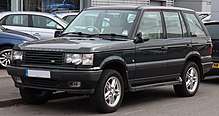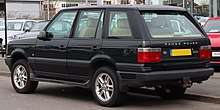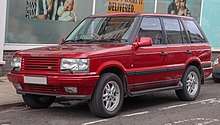Range Rover (P38A)
The Range Rover (LP) is the second-generation Range Rover model from British car maker Land Rover. It was launched on 28 September 1994, 24 years after the introduction of the first-generation Range Rover. It included an updated version of the Rover V8 engine, with the option of a 2.5-litre BMW six-cylinder turbo-diesel. The new model offered more equipment and premium trims, positioning the vehicle above the Land Rover Discovery to face the increased competition in the SUV marketplace.
| Range Rover (LP) | |
|---|---|
.jpg) | |
| Overview | |
| Manufacturer | Rover Group (1994-2000) Land Rover (Ford) (2000-01) |
| Production | 1994–2001 |
| Assembly | Solihull, United Kingdom |
| Designer | George Thomson (1990)[1][2] |
| Body and chassis | |
| Class | Full-size luxury SUV |
| Body style | 5-door SUV |
| Layout | Longitudinal front-engine, all-wheel drive |
| Powertrain | |
| Engine | Petrol 4.0 L Rover V8 4.6 L Rover V8 Diesel 2.5 L BMW M51 I6 |
| Transmission | 4-speed automatic 5-speed manual |
| Dimensions | |
| Wheelbase | 2,746 mm (108.1 in) |
| Length | 4,712 mm (185.5 in) |
| Width | 1,890 mm (74.4 in) |
| Height | 1,819 mm (71.6 in) |
| Chronology | |
| Predecessor | Range Rover "Classic" |
| Successor | Range Rover (L322) |
It is usually known as the Range Rover P38 or P38A outside of Land Rover, after the office building in which the vehicle development team was based. During the early development stages, the Engineering team was based in the Engineering Block at Solihull, and the vehicle was known by the project designations of 'Pegasus' and 'Discovery,' changing to P38A when the team moved to Block 38A at Solihull. The name 'Discovery' was used temporarily as a cover to confuse journalists while the original Discovery vehicle was being developed. During production Land Rover referred to it as either the 'New Range Rover' or by its model designation of 'LP'.
Specifications
_4.0_SE_wagon_01.jpg)



Engine
In 1999 the Range Rover V8 received a new Bosch engine management system from the BMW 7 Series (E38). This replaced the Lucas GEMS system. This engine is also known as the Bosch or Thor engine. It can easily be identified by its intake manifold.
The diesel edition received an EGR system, which came with a plastic inlet manifold. A modulator sends back part of the exhaust gas into the manifold, thus mixing hot exhaust gas via a vacuum pump into the cold air from the intercooler.
Suspension
The second generation incorporated new engine management and improved electronic air suspension (called EAS) that allowed automatic, speed determined height adjustment. The five suspension heights offered by EAS are (from lowest to highest in terms of height) "Access", "Motorway", "Standard", "Off-Road", and "Off-Road Extended". Height was also adjustable manually between the first four settings. The "Off-Road Extended" setting was only accessible automatically by the EAS ECU.
Transmission
The 4.0 L V8 petrol and the 2.5 L I6 diesel engine were mated to either the R380 manual gearbox or the ZF 4HP22 transmission, as used in the late classic Range Rover, 300 TDi, TD5 or V8 Discoverys. The 4.6 L V8 petrol engine was only mated to the ZF 4HP24 transmission.
The R380 gearbox is basically the same as in the previous Range Rover, or Discovery 300tdi. The primary shaft for the diesel is different with a small input diameter for the spigot bearing inside the BMW flywheel and the output shaft has been changed to allow for the different Borg Warner Box.
The Borg Warner transfer box no longer had direct control of High/Low range gears meaning that the vehicle has to nearly stop before shifting from high to low range and the lever from the classic model has been replaced by an electric control on the dashboard for the manual and an H-pattern gate on the automatic gear lever. The transfer case's chain and sprockets have been reinforced. The rear differential on the 4.6 L V8 petrol model were a 4-pin version and four-wheel traction control was included with the vehicle, whereas initially the 4.0 L V8 and the 2.5 L I6 only had 2-pin versions and two-wheel traction control on the rear wheels only. Later versions had the four-wheel traction control and the later 4.6 L V8 petrol model had a 4-pin front differential.
Chassis
The chassis was also made stronger and new welding techniques were used. This was the last Range Rover available with a manual gearbox and a classic transfer box. Other features included anti-lock braking system and in some automatic gearbox models two-wheel traction control — although later models saw this feature applied to all four wheels.
References
External links
- CVC Register - a club of enthusiasts who research and restore pre-production, press-launch and factory-owned P38 Range Rovers.
